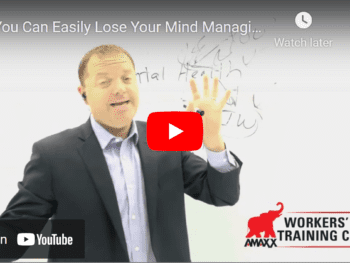
The MVP of Work Comp – the Employee!
Interested stakeholders need to treat the employee as an MVP. The benefits of this new mentality pay dividends:
- Employees want to go to work – and enjoy being at work;
- Employees give 100% effort and energy when they feel respected; and
- Employees want to get back to work quickly following an injury when they are treated like an MVP.
Now is the time to make the employee your workplace MVP.
Helping Employees Understand their Work Injury Responsibilities
The majority of focus in workers’ compensation is what the employer and insurance carrier should be doing. One of these items is educating the employee on their responsibilities regarding a work injury and how it can help them navigate the process.
The deck is stacked against the employee following a work injury. In many instances, the injury incurred is the first and only injury of their life. They are competing against experienced claim handlers who know the workers’ compensation law inside and out. While you can never thoroughly teach the employee about the process, you can provide basic information.
- Provide information in “plain language.”. This can include flowcharts and other fliers on how the workers’ compensation process works;
- Include information on the workers’ compensation process at employee onboarding, regular safety meetings, and annual training; and
- Ensure workers’ compensation forms and process charts are easily accessible. This should go beyond making sure the required forms are posted in a breakroom or other common spaces.
Continual education is essential. It will help the employee understand the process and how it works and demystify the process.
Help the Employee Prepare!
Employers and other interested stakeholders constantly prepare when it comes to injury presentation and response. One step that is missed is helping the employee prepare for a work injury. This is a step that must be included as it will reduce confusion and simplify the process.
There are many ways to help an employee prepare for a work injury. This can include the collection of emergency contact information. This is a form that should be updated on at least an annual basis. All information should be placed in safety and secure location to protect the employee’s privacy.
It is also essential to help all employees understand they need to be proactive in their workers’ compensation claims. This includes timely follow-up to verify a First Report of Injury is filed with the insurance carrier, medical authorizations may be requested by the insurance carrier, and pay stubs and out-of-pocket medical expense receipts need to be sent to the claim handler for timely reimbursement.
There is also the opportunity to think outside the box. One little-used suggestion that can help is preparing “employee medical ID cards.” The employee should carry this ID card at all times within the workplace. It should include basic information such as:
- Name;
- Date of birth;
- Blood type comorbid conditions;
- Allergies;
- List of Medications being used by the employee
- Emergency contact information; and
- Medical facility preferences.
To ensure privacy, this is information that should be added only by the employee. The card’s purpose is it allows responding medical personnel to have immediate access to an employee’s medical history should become unresponsive. It can also be used to best direct medical care.
Conclusions
There is a unique opportunity for interested stakeholders to educate their workforce to be successful in the workers’ compensation system. This includes taking proactive steps to inform their employees about the process and provide easy access to forms. The educational process never stops. There is also the opportunity to develop new strategies to prompt an effective injury response. Now is the time to help the employee develop best practices.
 Author Michael Stack, CEO Amaxx LLC. He is an expert in workers’ compensation cost containment systems and helps employers reduce their workers’ comp costs by 20% to 50%. He works as a consultant to large and mid-market clients, is a co-author of Your Ultimate Guide To Mastering Workers Comp Costs, a comprehensive step-by-step manual of cost containment strategies based on hands-on field experience, and is the founder & lead trainer of Amaxx Workers’ Comp Training Center, which offers the Certified Master of Workers’ Compensation national designation.
Author Michael Stack, CEO Amaxx LLC. He is an expert in workers’ compensation cost containment systems and helps employers reduce their workers’ comp costs by 20% to 50%. He works as a consultant to large and mid-market clients, is a co-author of Your Ultimate Guide To Mastering Workers Comp Costs, a comprehensive step-by-step manual of cost containment strategies based on hands-on field experience, and is the founder & lead trainer of Amaxx Workers’ Comp Training Center, which offers the Certified Master of Workers’ Compensation national designation.
Contact: mstack@reduceyourworkerscomp.com.
Workers’ Comp Roundup Blog: https://blog.reduceyourworkerscomp.com/
©2021 Amaxx LLC. All rights reserved under International Copyright Law.
Do not use this information without independent verification. All state laws vary. You should consult with your insurance broker, attorney, or qualified professional.






